
|
|
13 November, 2001
We got up early this morning to put on Extreme Cold Weather gear for our
flight to Marble Point. Dr. Bowser, Dr. Pollock, and I were going to this
area to scout out a place for a new collection site. A dive hole here
would allow Dr. Bowser's team to compare organisms and the underwater
environment beneath the ice at Explorers Cove with organisms a more
northern location. The helicopter was delayed due to weather conditions in
McMurdo. We left the field camp at New Harbor around 10:30 a.m. The
destination was a short helicopter ride from Explorers Cove. The
helicopter set down on the sea ice, and we quickly gathered gear, a
survival bag, helmets for the helicopter ride, nets, an ice pick, and
drilling equipment. Dr. Bowser immediately got on the radio to establish
contact with McMurdo. Radio contact is a "must" anytime someone leaves the
camp. While scouting for an optimal site for the dive hole, I saw bird
tracks in snow near a frozen stream. It is rare to see birds in this part
of Antarctica, so I was excited to see a Skua fly overhead.
After scouting the area, decisions were made as to the best places to drill
holes to test the depth of the water. The first drill hole went through 12
feet of ice to find water which was only 37 feet deep. The further we got
off shore, the deeper the depth of the water. After drilling five holes, a
depth of 92 feet was finally reached about 250 yards from shore. The two
men coming to blast were detained by windy conditions back at McMurdo. The
strong winds made it cold to stand out on the sea ice, so we found shelter
on the beach away from the wind. It was hard to walk at times as the wind
pushed us along the ice. Each step was taken with precautions to slipping
or falling into snow covered tidal cracks. It really helped to take Sea
Ice training before coming to the field. It taught me how to look for
unsafe ice, as well as how to drill holes into the ice.
I had trouble with my cameras and batteries getting cold, so I had to keep
them warm in my parka and bib overalls. When I took off my outer gloves to
connect the drill or take pictures, the tips of my fingers would get very
cold. Several times my gloves flew away as they escaped from my pockets.
It was hard to find enough places to "stuff" my cameras, film, batteries,
and gloves. The wind was so strong; it seemed to slice through the many
layers worn. I had on two layers of long underwear, two pair of pants,
including fleece pants, a fleece jacket, a wind jacket, bib overalls, the
big red parka, two hats, three pair of liner gloves, wool mittens, and
outer wind gloves. I was still colder than I've ever been in my life. It
wasn't the cold of Antarctica, but the wind. Even so, I couldn't stop
marveling at one of the most beautiful sites that I've ever seen &and
feeling fortunate to have this amazing opportunity to experience
ANTARCTICA and to parcticipate in Dr. Bowser's project.
We waited for two hours for the helicopter to bring the men with what Dr.
Bowser refers to as the "hole inducing agents" (dynamite). The blasters
carefully and safely prepared the charge. When detonated, the blast shot
ice high into the air. The blasters ensured we were far from the
explosion, and that there was no danger of getting hit by this flying ice.
After four such blasts, the helicopter was called because a perfectly
fashioned hole was created for diving. Our mission completed, we left one
of the most beautiful ice scenes on Earth. The snow covered mountains, the
glaciers meeting the sea, the icebergs frozen in the sea ice, the bluish
ice streams, the ice sculptures, and the huge rock formations made this a
memorable experience. It's not the cold, but rather the beauty of this
continent that will be remembered.

Dr. Bowser and I are in the helicopter heading for Marble Point. Dr. Bowser, Dr. Pollock, and I will scout out a place for a new dive site. This site will be used as a comparison to the Explorers Cove site in Dr. Bowser's study of foraminifera (forams).
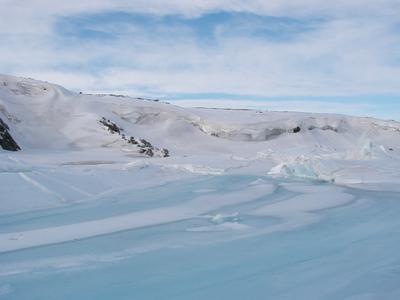
Although it was a cold and windy day, the scenery was beautiful as we looked for the perfect dive site for this comparison study. This frozen stream reminded me of a picture in a book.
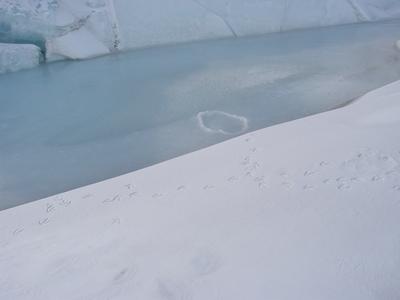
There are very few birds in this part of Antarctica, so I was excited to see the Skua and the bird tracks.

We walked along this transition zone (where land meets the sea) as we scouted out the area.
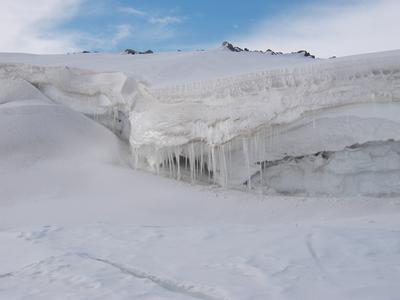
The icicles looked like icing on a cake.
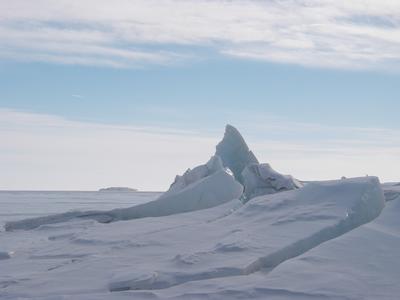
The ice sculptures are quite beautiful in Antarctica.

The wind was so cold today! I had on several layers, yet the cold still seemed to penetrate right through me. The surrounding beauty made me overlook the cold and appreciate the many experiences that I've had my first few days in Antarctica. As I walked along this snowy pathway, I couldn't help but think that this was truly the Antarctica that I had envisioned.
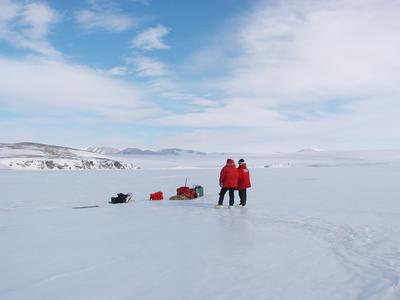
The helicopter let us out with all of our gear on the sea ice at Marble Point. We scouted the area, drilled several holes, and waited for another helicopter to come in with the blasters to blast a dive hole through the ice for a comparison study. As we looked around, we were the only ones at Marble Point. We saw one bird, bird tracks, and incredible scenery as we worked to prepare the site.
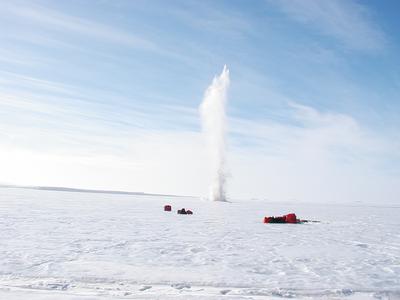
This blast was dedicated to my fourth grade students at West Elementary. Dr. Bowser, Dr. Pollock, and Phil Forte will come dive at this dive site tomorrow. They will make a comparison of the organisms, mainly the one-celled forams living under the ice at Marble Point. The water here in Antarctica is 28 degrees Fahrenheit.
Contact the TEA in the field at
.
If you cannot connect through your browser, copy the
TEA's e-mail address in the "To:" line of
your favorite e-mail package.
|
